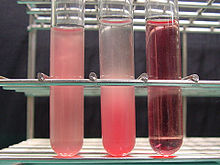Hemolysins

Erythrocyte suspension (left), sedimented after 60 minutes (in the middle, the supernatant is almost colorless), after 30 minutes at 37 ° C with the hemolysin of S. pyogenes (right)

α-hemolysin as a side view, the cell membrane lies between the red and blue lines (not shown)
Hemolysins (of hemolysis ) are substances which, in erythrocytes (red blood cells) a lysis effect. The cell membrane of the erythrocytes is perforated and the cytosol leaks out. This makes the hemolysins a toxin .
properties
Hemolysins are mostly proteins or lipids and act through various lysis mechanisms. Some of the protein-based hemolysins belong to the pore-forming toxins , while the lipid-based hemolysins act as surfactants and release the lipids from the cell membrane. Hemolysins are made by bacteria and fungi . They serve to provide nutrients and trace elements such as iron ions from the cytosol of the erythrocytes and sometimes also from other cell types such as leukocytes .
Individual evidence
- ↑ Provoda CJ, Lee KD: Bacterial pore-forming hemolysins and their use in the cytosolic delivery of macromolecules. In: Advanced drug delivery reviews. Volume 41, Number 2, March 2000, pp. 209-221, PMID 10699316 .
- ^ V. Nizet: Streptococcal beta-hemolysins: genetics and role in disease pathogenesis. In: Trends in Microbiology. Volume 10, Number 12, December 2002, pp. 575-580, PMID 12564994 .
- ^ AP Nayak, BJ Green, DH Beezhold: Fungal hemolysins. In: Medical mycology. Volume 51, number 1, January 2013, pp. 1–16, doi : 10.3109 / 13693786.2012.698025 , PMID 22769586 , PMC 4663657 (free full text).
- ^ SJ Vesper, MJ Vesper: Possible role of fungal hemolysins in sick building syndrome. In: Advances in applied microbiology. Volume 55, 2004, pp. 191-213, doi : 10.1016 / S0065-2164 (04) 55007-4 , PMID 15350795 .
- ↑ M. Sritharan: Iron and bacterial virulence. In: Indian journal of medical microbiology. Volume 24, Number 3, July 2006, pp. 163-164, PMID 16912433 .